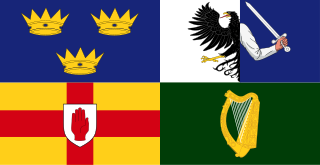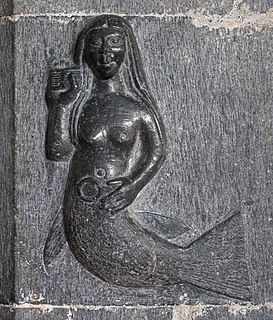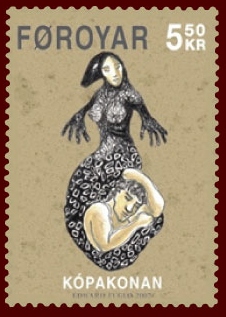 W
WThe aos sí is the Irish term for a supernatural race in Irish mythology and Scottish mythology, comparable to the fairies or elves.
 W
WThe Celtic deities are known from a variety of sources such as written Celtic mythology, ancient places of worship, statues, engravings, religious objects, as well as place and personal names.
 W
WFigures in Irish mythology include the following:
 W
WIn Irish mythology, Abarta, was in some accounts one of the Tuatha Dé Danann and in others a Fomorian, and is associated with Fionn mac Cumhaill.
 W
WAbhartach Irish pronunciation: [ˈawəɾˠt̪ˠax] is an early Irish legend, which was first collected in Patrick Weston Joyce's The Origin and History of Irish Names of Places (1875). Abhartach should not be confused with the similarly named Abartach, a figure associated with Fionn mac Cumhaill.
 W
WA banshee is a female spirit in Irish folklore who heralds the death of a family member, usually by wailing, shrieking, or keening. Her name is connected to the mythologically important tumuli or "mounds" that dot the Irish countryside, which are known as síde in Old Irish.
 W
WThe cat-sìth, in Irish cat sí is a fairy creature from Celtic mythology, said to resemble a large black cat with a white spot on its chest. Legend has it that the spectral cat haunts the Scottish Highlands. The legends surrounding this creature are more common in Scottish folklore, but a few occur in Irish. Some common folklore suggested that the cat-sìth was not a fairy, but a witch that could transform into a cat nine times.
 W
WA changeling, also historically referred to as an auf or oaf, is a human-like creature found in folklore and folk religion throughout Europe. A changeling was believed to be a fairy child that had been left in place of a human child stolen by the fairies. The theme of the swapped child is common in medieval literature and reflects concern over infants thought to be afflicted with unexplained diseases, disorders, or developmental disabilities.
 W
WThe clurichaun or clúrachán is a mischievous fairy in Irish folklore known for his great love of drinking and a tendency to haunt breweries, pubs and wine cellars. He is related to the leprechaun and has sometimes been conflated with him as a shoemaker and a guardian of hidden treasure. This has led some folklorists to suppose that the clurichaun is merely a leprechaun on a drinking spree, while others regard them as regional variations of the same being. Like the leprechaun, the clurichaun is a solitary fairy, encountered alone rather than in groups, as distinct from the trooping fairies.
 W
WThe aos sí is the Irish term for a supernatural race in Irish mythology and Scottish mythology, comparable to the fairies or elves.
 W
WThe Dobhar-chú or King Otter is a creature of Irish folklore. It resembles both a dog and an otter, though it sometimes is described as half dog, half fish. It lives in water and has fur with protective properties.
 W
WThe Dullahan, Durahan or Dullaghan, also called Gan Ceann, is a type of mythological creature in Irish folklore.
 W
WThe each-uisge is a water spirit in Scottish folklore, known as the each-uisce in Ireland and cabyll-ushtey on the Isle of Man. It usually takes the form of a horse, and is similar to the kelpie but far more vicious.
 W
WThe Ellén Trechend is a three-headed monster referred to in Irish mythology. It is mentioned in the text Cath Maige Mucrama as having emerged from the cave of Cruachan and laid Ireland waste until it was killed by the Ulaid poet and hero Amergin.
 W
WIn Scottish folklore the fachan is a monster or giant described by John Francis Campbell in Popular Tales of the West Highlands as having a single eye in the middle of its face, a single hand protruding from its chest instead of arms, and a single leg emerging from its central axis. It has a single tuft of hair on the top of its head, regarding which Campbell says "it were easier to take a mountain from the root than to bend that tuft." Campbell draws attention to the possible influence of creatures from Arabic tradition such as the Nesnas or Shikk, described as "half of a human being" and hopping about on one leg with great agility.
 W
WA far darrig or fear dearg is a faerie of Irish mythology. The name far darrig is an Anglophone pronunciation of the Irish words fear dearg, meaning Red Man, as the far darrig is said to wear a red coat and cap. They are also sometimes known as Rat Boys as they are said to be rather fat, have dark, hairy skin, long snouts and skinny tails. According to Fairy and Folk Tales of the Irish Peasantry, the far darrig is classified as a solitary fairy along with the leprechaun and the clurichaun, all of whom are "most sluttish, slouching, jeering, mischievous phantoms". The far darrig in particular is described as one who "busies himself with practical joking, especially with gruesome joking". One example of this is replacing babies with changelings. They are also said to have some connection to nightmares.
 W
WIn Irish mythology, the fear gorta is a phantom of hunger resembling an emaciated human.
 W
WA fuath is a class of malevolent spirits in Scottish Highland folklore, especially water spirits.
 W
WA gancanagh is a male fairy in Irish mythology that is known for seducing men and women.
 W
WIn Celtic mythology, a Joint-eater, Just-halver or Alp-luachra (Ireland) is a type of fairy who sits invisibly and consumes half of their victim's food. When a person falls asleep by the side of a spring or stream, the Alp-luachra appears in the form of a newt and crawls down the person's mouth, feeding off the food that they had eaten. In Robert Kirk's Secret Commonwealth of Fairies, this creature feeds not on the food itself, but on the "pith or quintessence" of the food.
 W
WThe leannán sídhe is a figure from Irish Folklore. She is depicted as a beautiful woman of the Aos Sí who takes a human lover. Lovers of the leannán sídhe are said to live brief, though highly inspired, lives. The name comes from the Gaelic words for a sweetheart, lover, or concubine and the term for inhabitants of fairy mounds (fairy). While the leannán sídhe is most often depicted as a female fairy, there is at least one reference to a male leannán sídhe troubling a mortal woman.
 W
WMerrow is a mermaid or merman in Irish folklore. The term is of Hiberno-English origin.
 W
WThe Oilliphéist is a sea serpent-like monster in Irish mythology and folklore.
 W
WThe púca, pooka, phouka is primarily a creature of Celtic folklore. Considered to be bringers both of good and bad fortune, they could help or hinder rural and marine communities. Púcaí can have dark or white fur or hair. The creatures were said to be shape-changers, which could take the appearance of horses, goats, cats, dogs, and hares. They may also take a human form, which includes various animal features, such as ears or a tail.
 W
WIn Norse and Celtic mythology, selkies or selkie folk meaning "seal folk" are mythological beings capable of therianthropy, changing from seal to human form by shedding their skin. They are found in folktales and mythology originating from the Northern Isles of Scotland.